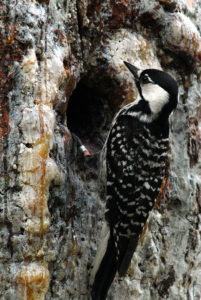The red-cockaded woodpecker (RCWO) is a small – cardinal-sized – woodpecker native to eastern pine forests. It once ranged from New Jersey southward to Florida and westward to eastern Texas and portions of Oklahoma and Missouri. The RCWO is dependent upon old growth pine forests, especially longleaf pine. Early European settlers saw the great forests of eastern North America, first as an impediment to settlement and shortly thereafter as a resource and began to methodically clear those forests. The Industrial Revolution of the mid 1800s with its steam-generated power and locomotives to move logs to mill and market increased the rate of deforestation across the East greatly reducing RCWO habitat.
Even as the timber industry (in the early 1900s) began to come around to Gifford Pinchot’s idea of a “conservation ethic,” the RCWO still found itself the odd man out. While forestry had certainly changed for the better with a more sustainable outlook, profitability and the perception of forests as simply commodities still reigned supreme.
The devil–in-the-details is a fungus known as Phellinus pini. This fungus leads to a disease known as red-heart disease in southern pines. From a timbering standpoint red-heart does not become an issue until pines reach a ripe old age – around 75 to 80-plus years. The solution for foresters is pretty straightforward and simple – harvest pines on a rotational basis before they reach that 80-year mark.
However, for the RCWO that is still a death knell. What foresters and the timber industry perceive as a devastating disease, Ma Nature sees as simply another niche. RCWOs are the only woodpeckers to make their nesting cavities in living trees. There is a caveat – they primarily nest in old growth pines (particularly longleaf pines) infected with red-heart disease, which softens the heartwood making cavity construction possible. The elimination of red-heart and/or pines with red-heart means the elimination of the RCWO.
The RCWO graced the eastern forests along with the passenger pigeon, the Carolina parakeet and the ivory-billed woodpecker and prior to being listed as Federally Endangered in October 1970 this small woodpecker was poised to follow its avian compatriots into the abyss of extinction. The listing afforded the RCWO some protection – gave it some breathing room and protected small remnant populations across the Southeast.
Francis Marion National Forest in the coastal plain of South Carolina was one of the strongholds for the endangered RCWO. By the mid 1980s, Francis Marion was home to the second largest and densest population of RCWOs in the country. The Francis Marion birds were also, at the time, the only naturally increasing population of RCWOs in the U.S. Then around midnight on September 22, 1989 Hurricane Hugo bowled into Sullivan’s Isle, SC as a Category 4 storm. Before daybreak the 100+ m.p.h. winds had wiped out half of Francis Marion’s RCWO population and destroyed 90 percent of the cavity trees in the forest.
This was catastrophic because it generally takes RCWOs between one and three years to create a nesting cavity. Biologists knew there was no way the population could recover on its own. But there was a silver lining. Researchers had been studying the use of man-made cavities as a means of enhancing RCWO populations. Though there had been no large-scale trials of the protocol, researchers began installing the artificial cavities across the forest. The woodpeckers responded positively. Today, the Francis Marion population of RCWOs is once again naturally increasing and numbers exceed pre-Hugo levels and the protocol of using artificial cavities is helping to expand the population.
According to Jestin Clark, biologist at Francis Marion, the Forest Service and partners are currently reintroducing RCWOs to the Ashepoo, Combahee and Edisto (ACE) Basin in coastal South Carolina. More than 10 pairs of birds have been relocated to the ACE Basin.

